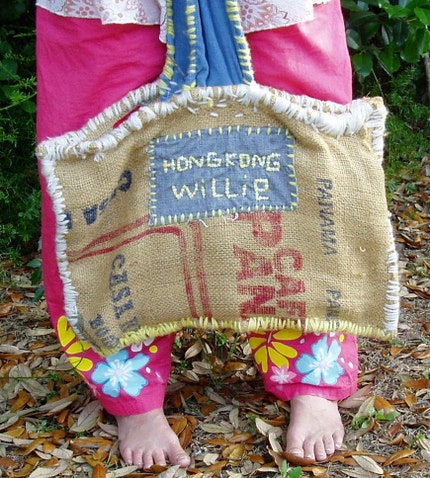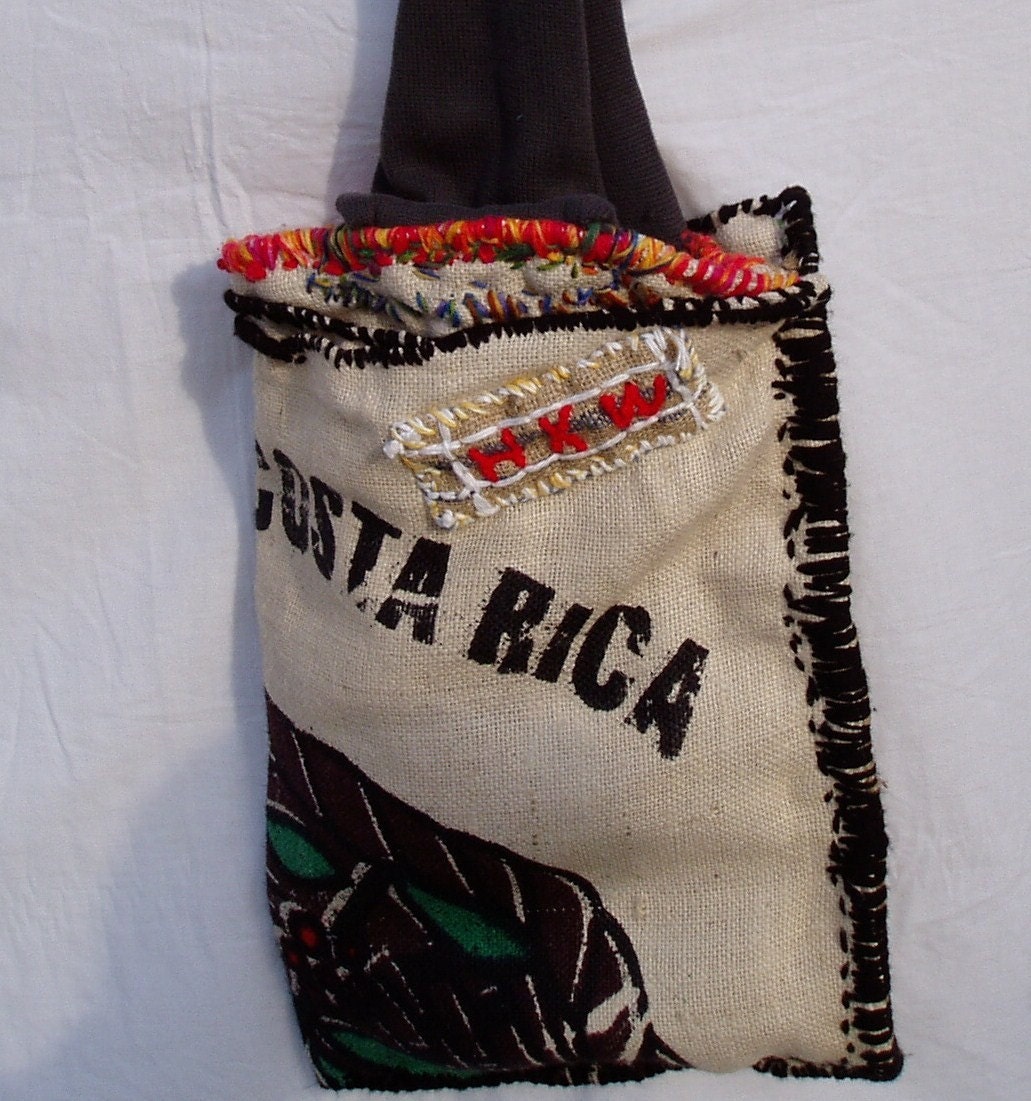GREEN HIPPIE BAG
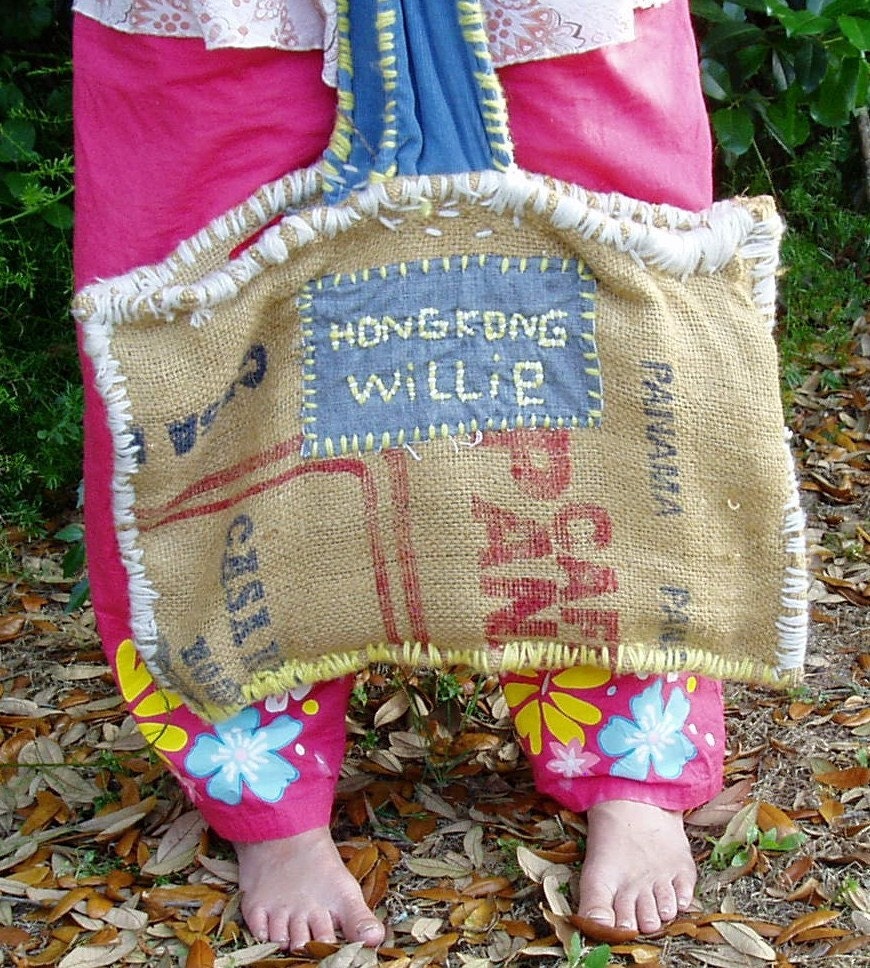


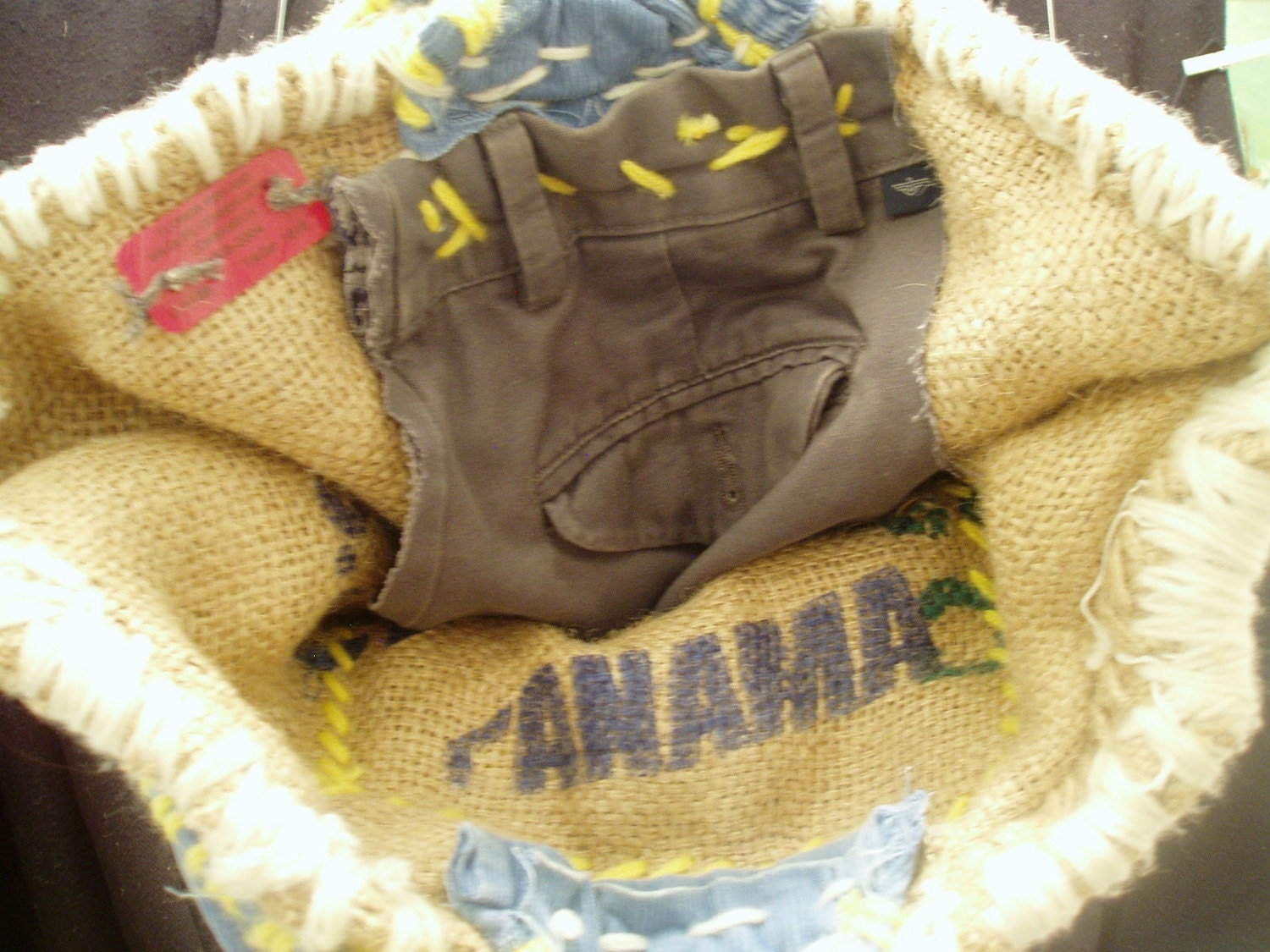

Please View:
Hand Made Bag
Shell: Burlap Coffee Bag
Source: Third Generation Coffee Roaster
Stitching: Recovered Vintage Yarn
Source: Key West
Handle, Label, Pockets:
Source: Artist Worn Clothing (HKW)
Inner Pocket: 1
Outer Pocket: 1
Dimensions:
Length(Strap to Bottom)-23"
Actual Length-14"
Width-20"
Reuse artist.
Hong Kong Willie.Famous Reuse Artist. Artist of the 60’s in the now. Acclaimed Famous Florida folk artist, Living the Life of using objects for many uses. Follow the travels of life
FOX TV ON HONG KONG WILLIE, HONG KONG WILLIE IS GREEN
Artist Born for this time, Lived on a landfill as a child. Reuse Became the way of life. To read the story from the inception of the Name Hong Kong Willie. Famed, by the humble statements from the Key West Citizen, viable art from reuse has found its time. To Live a life in the art world and be so blessed to make a social impact. Artists are to give back, talent is to tell a story, to make change. Reuse is a life experience.
Hong Kong Willie Art Gallery In Tampa, a reuse Art Gallery. Artist Kim,Derek,and Joseph. reuse artist that have lived the life and are meant for the green movement in the world. A gallery that was born for this time. Artist living a freegan life,art that makes a social statement of reuse. Media that has a profound effect in making the word green truly a movement of reuse in the world today and the future.
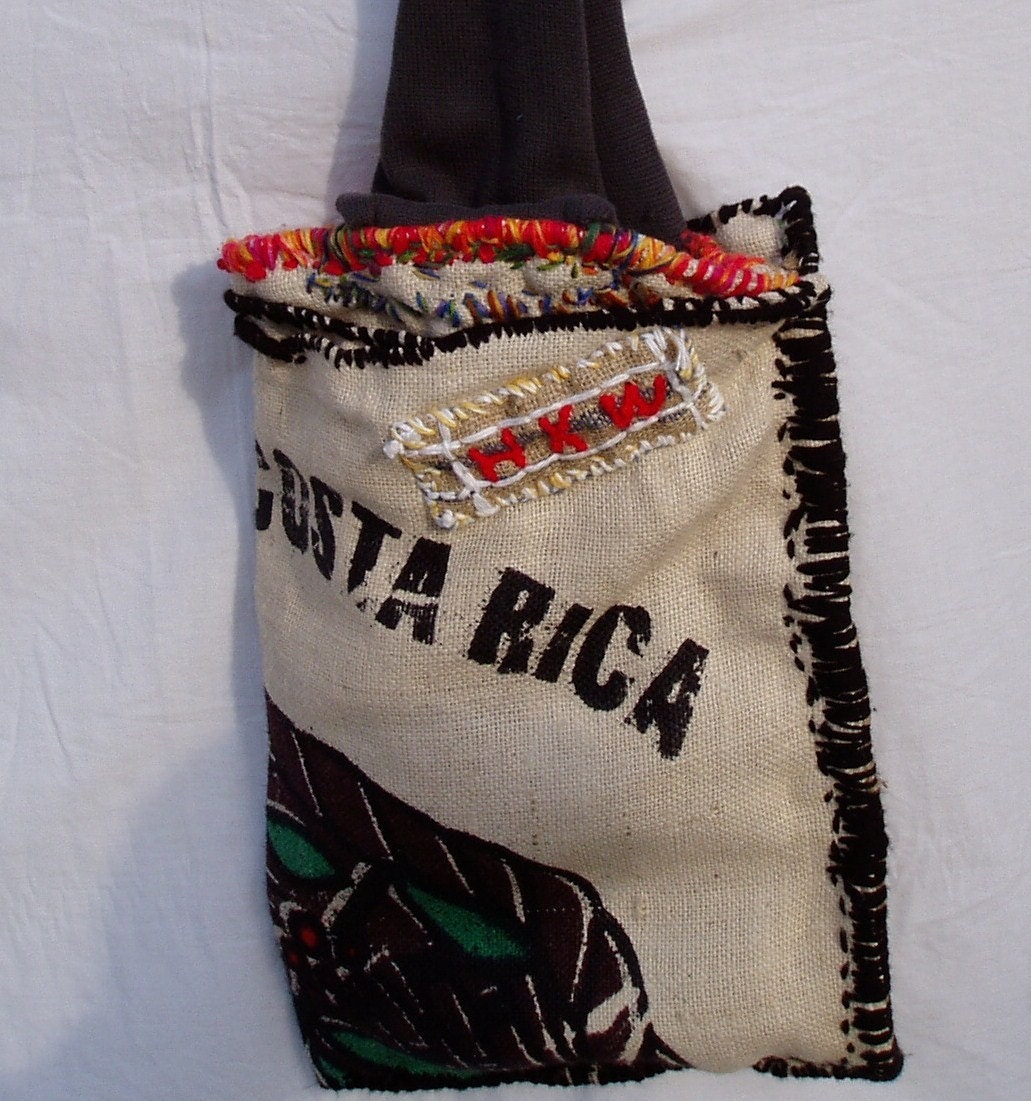
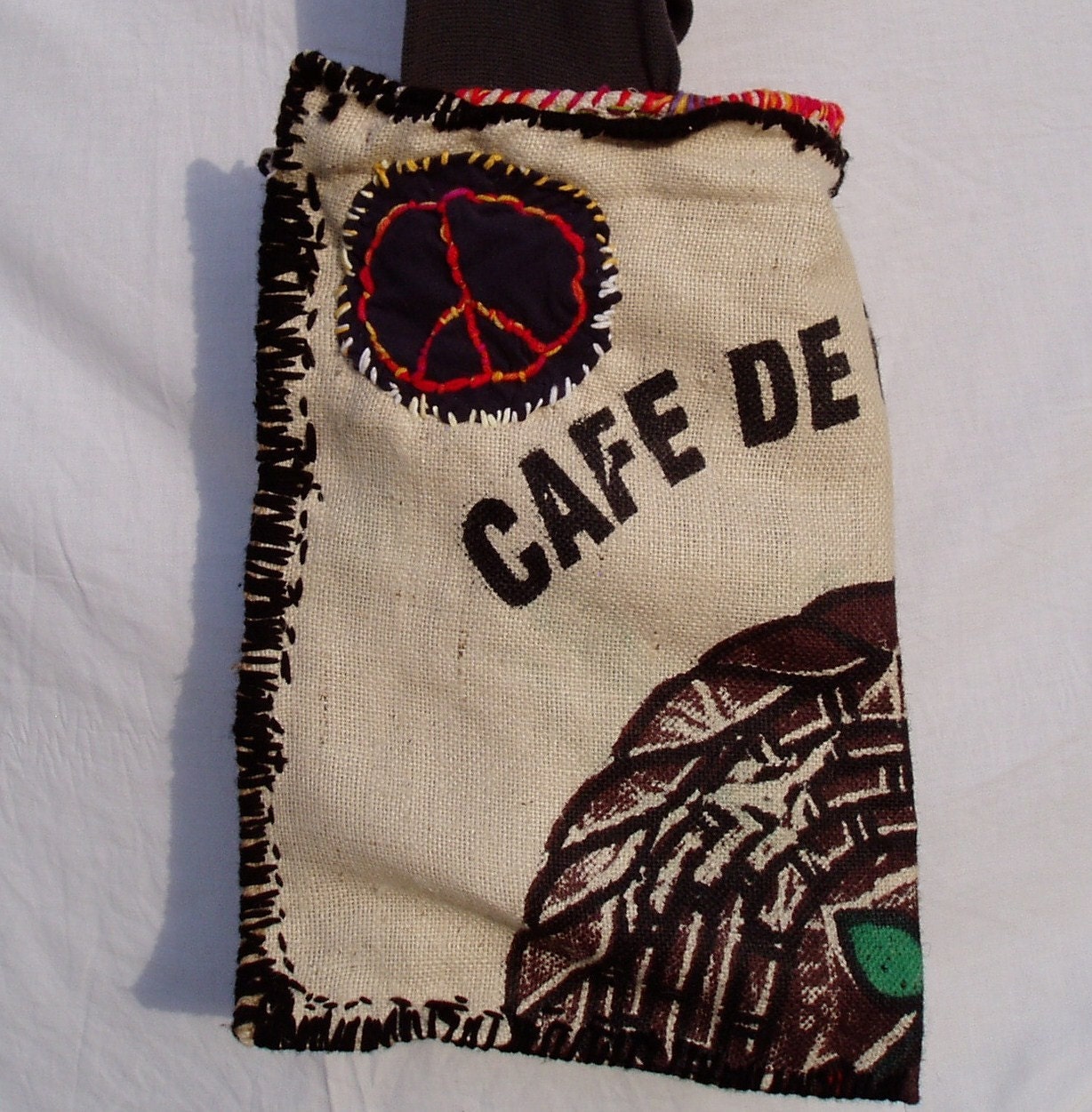
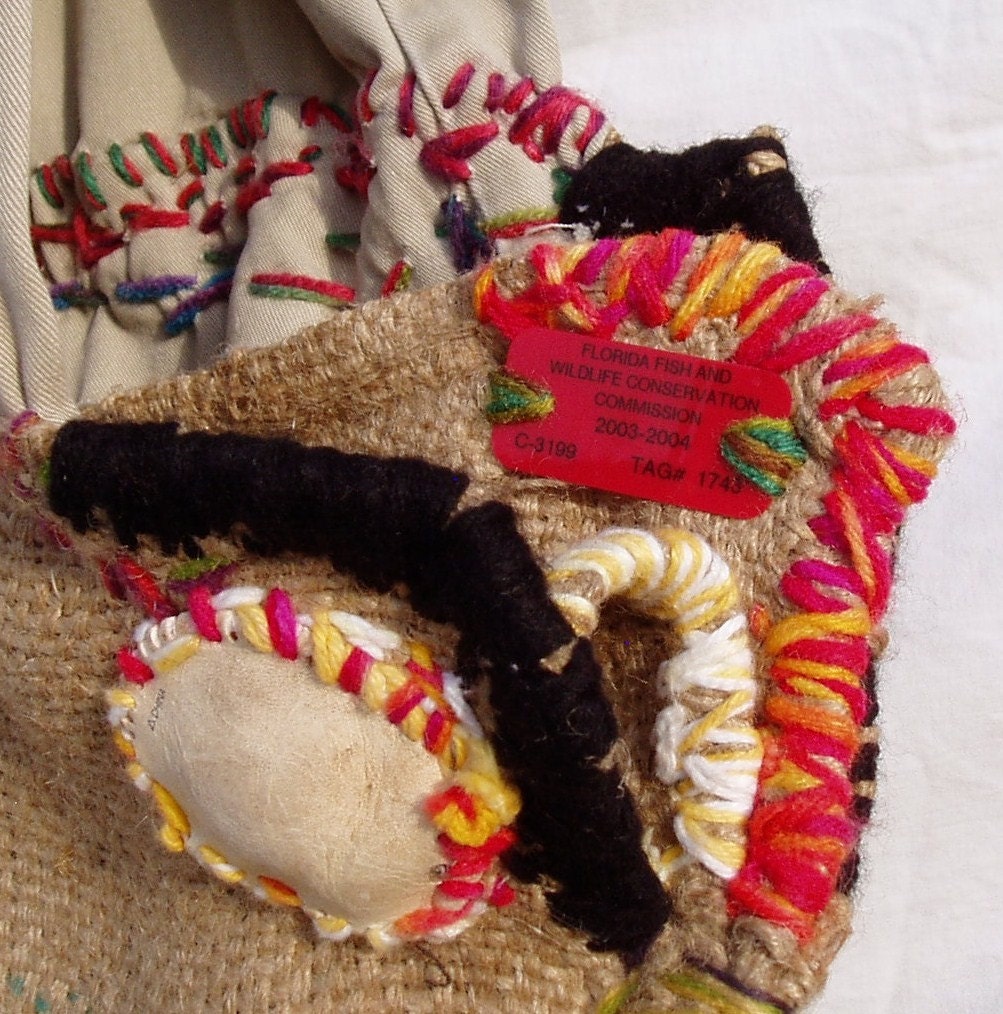
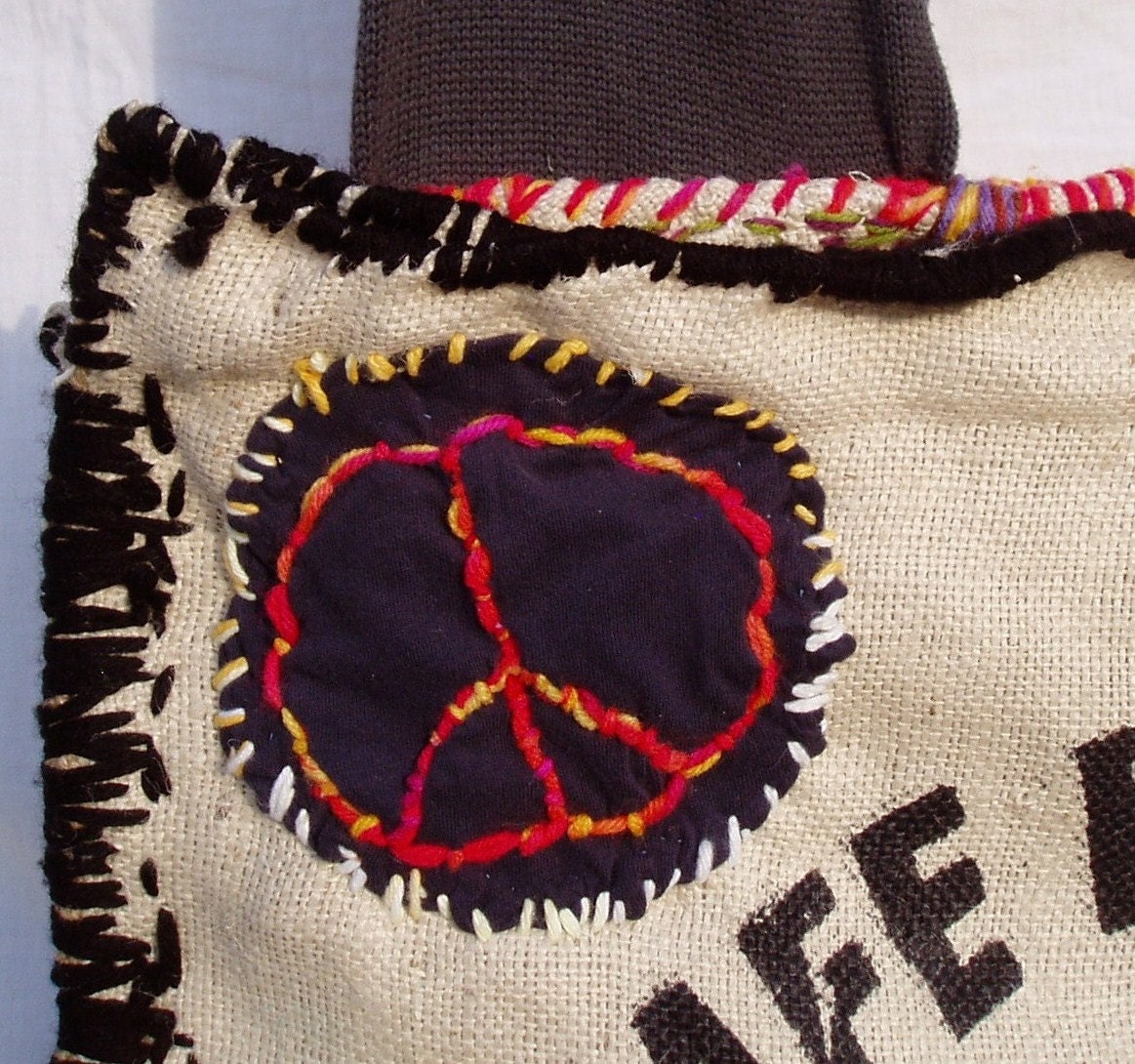
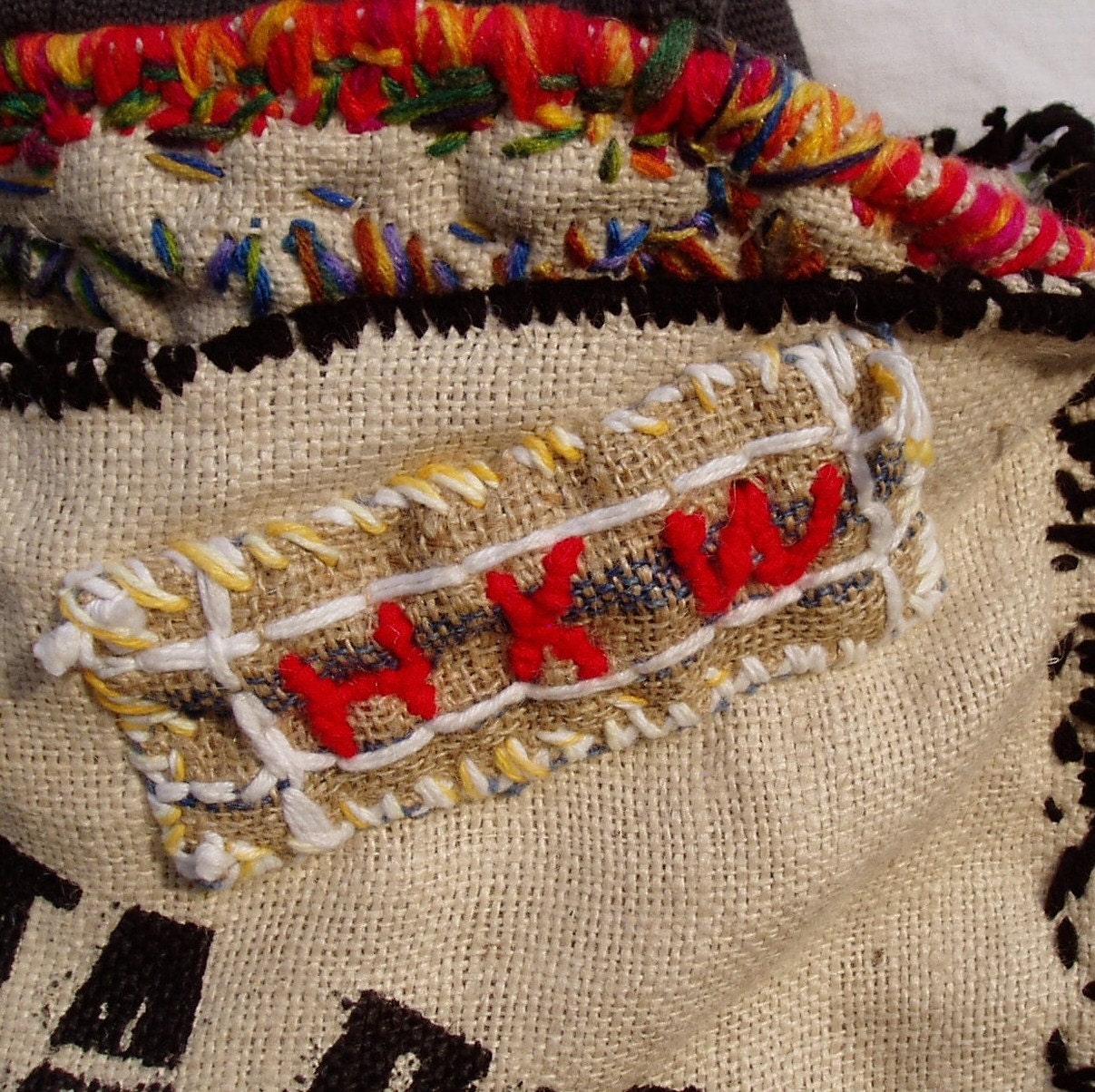
Hand Made Bag
Shell: Burlap Coffee Bag
Source: Third Generation Coffee Roaster
Stitching: Recovered Yarn
Source: Key West
Handle, Label, Pockets:
Source: Artist Worn Clothing (HKW)
Inner Chambers: 3
Dimensions:
Length(Strap to Bottom)-37"
Actual Length-10"
Width-14"
ROADSIDE ATTRACTION
Jim Tunstall TAMPA TRIBUNE
A break with the mainstream led a couple to their own little corner of happiness from another day in time.
" I believe every individual has a purpose. When you start going on your journey to discover yours, you learn some things along the way."
JOE BROWN
Joe Brown loves to express himself.
If you want to see how, take a spin by his place on the southwest corner of Interstate 75 and Fletcher Avenue. His yard is coiffed with a sassy blend of crab-trap buoys, bottle art, fishy wind socks and a dog and two cats that co-exist on a mainly peaceful basis.
Then there's the man. Brown, a page out of the 1960's better side, owns A-24 Hour Bait and Tackle.
On one hand, he's private enough not to want his photograph taken, on the other, he's gregarious enough to talk the ears off anyone interested in fishing. Fact is, this 51-year-old Tampa native is primed to gab about next best to anything on the minds of his visitors, including the way things used to be.
Like in 1983 when he and his wife, Kim, planted roots on this corner and the new Interstate was their only new neighbor.
Before that, Brown had been part of the establishment, but he chucked his mainstream career and spent 3 years on a 700-hundred acre spread across Fletcher, searching for himself.
I was seriously unhappy," he says.
"I left (the job) Nov. 13, 1981. That Date, the moment I left the office, it blazed in my brain, I was 31 and dealing with severe depression."
One day he heard a voice.
"People will tell you you've got serious problems when you hear voices," he says behind a grin. "But this wasn't that kind of experience. It just said, 'Joe, what if it gets better?'"
Well, slowly it did.
He and Kim took an option on the corner that been home to a worm farm for 25 years.
" The worm business was at it's ebb," Brown says.
" I bought it to sell. I had no idea I was going to continue it."
Over the years, neighbors started putting down roots to the west, including apartment complexes and more than a half dozen hotels, such as Extended Stay America and Residence Inn.
The bait and tackle business stayed reasonably strong until the economy went south last year, Brown says, adding that he still carries a full line of rods, reels, cane poles, lures, crickets, shiners, and shrimp.
" But we did a lot a wholesale and we lost 90 percent of that business Sep. 11," he says." " That's dead. It's not coming back."
Fortunately the Browns have branched out.
Last year, they opened a gift shop that sells gator heads, sea shells, stuffed critters, t-shirts, and other trinkets.
Brown also started dabbling in bottle art -- melting everything from vodka to Sprite bottles, reshaping them then letting them cool and harden.
Through the last 20 years, he seems to have learned to be a survivor.
He's also learned his reason for being on this corner.
"I believe every individual has a purpose," he says, turning serious for a moment.
"When you start going on your journey to discover yours, you learn some things along the way. I like working with the public and making them happy. And if you're doing what you want to do, it's a beautiful thing."
BUOY OH BUOY
BITS OF THE BEACH
BILL DURYEA
TIMES STAFF WRITER
A BAY AREA BUSINESS COUPLE SALVAGES DEBRIS FROM THE KEYS THAT CAN BUOY ANY ATMOSPHERE.
TAMPA-- Every month or so, Kim and Joe Brown pile into the family flatbed truck, he one that's decorated with multi-colored stencils of fern fronds, and drive down to Key West.
There, they inevitably find what they're looking for: a few thousand discarded plastic foam crab and lobster buoys, maybe a battered surf board or a life preserver. After a week or so, they strap the whole load down, turn the truck around and head home to Fletcher Avenue at Interstate-75, where they have lived for nearly 25 years.
If you've driven by there recently, and you'd know if you'd had, then you have a pretty good idea, of what the Brown's do with the buoys once they get them off the truck.
They wrap them around metal poles, until they resemble marshmellow Christmas trees. They festoon them outside the gift and bait shop they run. They line their parking lot with them.
"It can drive you crazy," Kim Brown said as she stared at a mound of them. "There's got to be something else to do with them. I was thinking maybe I'd cut them in half and make them into little planters."
Occasionaly, a restaurant owner who fancies a nautical theme will relieve them of a few thousand buoys. Sometimes a home owner from New Tampa wants a dozen for his new poolside bar.
But generally speaking, the treasures of the Key West trips come in at a rate far faster than they go out. Doesn't matter a bit to the Browns.
"I have a pretty good life. I don't have to bust my butt," Kim Brown said. "I don't make a lot of money, but when someone likes my stuff, that's cool."
In a corner of Tampa dominated by late-arriving corporate parks and hotel chains, they live a life of enviable self-sufficiency. If they appear eccentric, it is only by the relelentlessly conformist standards of their neighbors. If the decor appears kitschy, maybe it's because we've lost touch with what's truly authentic.
On a recent morning, Kim Brown was giving an impromptu tour to a surprise visitor. She was wearing a loose-fitting white shirt and a long gray cotton skirt. Walking around in her tanned bare feet and sunglasses she seemed glamorous and unfussy. She casually mentions her age, 46, without a trace of self-consciousness.
The sky was threatening rain and that wasn't doing much for sales at A-24 Hour Bait. "Fish are going to eat today," she says, shaking her head at the squandered opportunity.
But it gave her time to tell some stories.
"Those rings, they came from a Cuban refugee raft," she says, indicating a clump of artifacts outside thet baitshop. " When I can, I take a picture of the man or the woman and that becomes part of the story of what we sell."
She grabbed a bass lure dangling from the inside of a metal cylinder and gave it a good tug. It clanged loudly. "We make the bells out of dive tanks that were going to be thrown away," she says.
"I've got a real nice anchor. It's over 100 years old. That came from a Cuban who got it caught in his lobster traps."
"The Lobster guys are lucky," she says with real admiration in her voice. "They find this stuff all the time, just floating out there."
Kim grew up near Lowry Park Zoo. Her husband was raised out on Anderson Road. They met in 1981, the circumstances of which are one of a few stories she's reluctant to tell in detail. At the time she was boarding horses across the road in what is now the Hidden River Corporate Park.
"When I met Joe, he was in a suit and tie. He always had a thousand dollars on his back," she said. He was in the materials handling business, but it wasn't long for that corporate life.
They saw some land was available for sale on Morris Bridge Road, the part where it bends in the southwest corner of I-75 and Fletcher. The acre or so had a worm farm on it when they bought it. The previous owner had a Coca-Cola cooler out front, and fishermen on their way to the Hillsborough River would come by and fill a can with worms, leave a little money in a cup. All on the honour system.
"That tapered off. Fishng wasn't simple anymore. You couldn't just get a cane pole and a can of worms and go catch some dinner," Kim says. "Now you've got to have permits and expensive reels and the latest lure."
"That's why we kind of went back to our art."
In the early 1990's they made their first trip down to the keys. They began to meet fishermen. They stayed in their homes, ate dinner with them. Joined in the parties at the beginning of stone crab season.
It wasn't long before they saw all the buoys overflowing the trash cans. Buoys generally last a few years. Turtles gnaw them. Storms scatter them. Sun and salt bleach them.
"Hey, we can do something with those," Kim remembers saying. "We make something out of nothing."
The gift shop, known as Hong Kong Willie, is full of stuff that was perilously close to oblivion before the Browns identified some hidden potential.
Kim makes "coconut grams". They're painted coconuts with a space clearly marked for the address. There's not much room for the message. But the U.S. Postal Service will actually deliver them, Kim says.
The gift shop's ceiling is packed with coffee sacks. Glass bottles that have been heated in the Brown's kilns sit on shelves slumped like Dali clocks. Gnarled pieces of polished Lignum Vitae are scattered about; Kim's son Derek, 22, is responsible for that work.
Nothing has a price, because prices depend on too many variables for it to be worth specifying. (A string of five buoys will cost you $12.99, though the price drops for bulk purchases.) But whenever possible a piece will come with a picture of the shop, or of the person who provided the piece, to commemorate the item's passage
through history.
"This telephone was on Duval Street," Kim says. "It's got all these names and numbers written on the side. And a picture of a raccoon on the front. Who knows why?"
The demand for items such as this is unpredictable. Ditto the 1961 mailbox with the rusted front. But the Browns' customers tend to share their enthusiasm.
"I bought 1,200 buoys a month ago," said Jimmy Ciaccio, owner of Gaspar's, a restaurant on 56th Street in Temple Terrace that has a brand new patio with an aggressive Key West theme.
"I must have 3,000 of them around here," Ciaccio says as he walks the deck, talking a torrent. "I got a raft, those traps, they all came from Joe. I've bought a lot of novelty stuff from them. That's what they're all about and that's what we're all about. And there's always a story behind everything. I love that. He gave me that thing, it's like a piece of wood or something I don't know what it is, but it's from Key West. We've got that chemistry."
If there were a few more customers as fervid as Ciaccio, Kim Brown might not be toying with the idea of getting into the food business. But there aren't and she is.
"Not everybody wants a buoy or a bell," Kim says. "But everyone wants to drink a cup of coffee. I don't want to be a Starbucks but maybe a little coffee shop. Maybe a good Cuban sandwich."
"But then you get into hiring and firing. I've got friends in the retaurant business. I see how hard they work. It's never-ending," she says, beginning to argue with herself. "I just don't want to work that hard."
She circles back to a calm contentment with life as it is currently defined.
"We're happy. We don't want to sell. We're not rich, but we pay our bills.
The zen of junk
A Tampa couple devotes itself to creating something from nothing
BY ALEX PICKETT
Located off East Fletcher Road between hotel chains and high-end office parks is the gift shop and folk art gallery Hong Kong Willie's.Drive south on I-75, look to the right around East Fletcher Avenue, and you can't miss it. The tree appears first, hundreds of buoys wrapped around its branches, resembling a sort of Dr. Seuss-ian Christmas ornament. Then the rest of the 20,000 buoys come into view -- thousands of strands of the multicolored foam balls stretching from the tree to two wooden shacks, hanging from their roofs and walls, and stretched out over the property.
Strewn about the lawn is a menagerie of surfboards, car doors, CB radios, wooden sculptures and painted signs. A 1979 Ford pickup sits in the front driveway, painted with a rainbow of colors, four racks of antlers affixed to its roof. An old stuffed caribou sits in a lawn chair beckoning visitors.
Of the thousands of motorists who pass by this eclectic landmark off Exit 266 every day, few stop in the funky gift shop and Key West-themed folk art gallery that is Hong Kong Willie's. But this is not your typical roadside store selling cheesy Florida magnets and beach T-shirts (although they have those, too). From the moment the owners come out to greet you, it's clear that for them this isn't just a business -- it's a lifestyle.
As I step out of my car, Joe Brown ambles toward me wearing a red Hawaiian shirt and khaki shorts. With his disheveled shoulder-length brown hair and strong jaw line, Brown, 56, looks a lot like Mel Gibson in Braveheart. He ends most of his sentences with "Do you follow me?" and stares with wild gray eyes until you nod in agreement. His 46-year-old wife, Kim, who bears a strong resemblance to Grace Slick, sits near the shop's open sign, branding her latest creation. Wearing large sunglasses, she gives a smile, hardly looking up.
Joe and Kim -- Tampa natives -- bought the half-acre property off Fletcher Avenue and Morris Bridge Road in 1985. For the next two decades, the Browns operated A-24 Hour Bait and Tackle, living on the premises and bagging worms for K-Mart and Wal-Mart to make a few extra bucks. But in 2001, they decided to abandon fish food to pursue the fickle business of art, although they will tell you Hong Kong Willie's was always "part of the journey."
"We were artists," says Joe. "We were born that way. We had no choice. You follow me?"
The underlying theme of Hong Kong Willie's is creating art out of objects destined for the landfill, and while browsing the items, I get the feeling the Browns are trying to make a point rather than a sale.
"Thirty percent of the gifts given will be in the dumpster by next Christmas," Joe says. "Most Christmas gifts will be given because they think they have to. Very few will have a social impact."
Every item at Hong Kong Willie's is either art made out of an object destined for the landfill or products that other companies were throwing away and the Browns retrieved before they made it to the dumpster. But don't call this recycled art. The Browns prefer "preservation."
Recycling implies the material will be used for the same purpose. "If you get stuck in that word, then you get stuck in that form," Joe explains. Instead, the Browns create a whole new use for an item that would have been otherwise thrown away.
Kim looks up from her painting after Joe finishes his long ramble. "We've always been able to take nothing and make something out of it," she says.
Although most people assume Joe is "Hong Kong Willie," he says the name refers to the origin of junk: Hong Kong produces much of the useless merchandise that Americans buy and quickly throw away, he says. So it's up to the Willies of the world -- i.e. the Browns and other conservationists -- to find new uses for the trash.
"All of us who believe what we believe is Hong Kong Willie," Joe says.
The gift shop is a space not much bigger than a tool shed, cluttered with handmade candles, pottery, ceramic figures and deer skulls painted tie-dye style. Joe, who's not content to allow me to wander by myself, darts from item to item, sharing each one's origins. One of the first objects he shows me is an old scuba tank cut in half, stenciled with yellow and purple spray paint with a weighted rope attached on the inside. What would have been a heavy addition to a landfill or junkyard, the Browns now sell as a nautical-themed bell. Another popular item: a used Starbucks Frappuccino bottle filled with sand and shells, and the words "Florida Beachfront Property" written in paint on it.
"Is it really pragmatic to say this had one life -- to have Frappuccino in it?" he says, holding up the $3 gift. "That's not true. You follow me?"
Joe picks up a droopy glass vase -- the result of an Arizona Ice Tea bottle stuck in a kiln for too long. He says it's a collector's item: Only 300 were made and none look alike.
"People really want something that is one of a kind and something that means something," he says, holding up the vase and pointing to a stack of Beanie Babies. "Which one is the real collectible? The one that cannot be copied or the one that is mass-produced just on a small scale? You follow me?"
Most of the materials the Browns work with come from Key West. Every few months they hop in the pickup, drive the 425 miles to the Keys and start looking for the junk no one else wants: used dive tanks, the lobster trap buoys, burlap bags and even old wooden planks from ships or homes destroyed by storms.
In fact, the latter is one of their biggest sellers. They bring back an imperfect piece of lumber, slap some urethane on it and Kim paints everything from colorful fish and birds to old Key West landmarks on it. Every piece is branded, marked with a lobster cage tag and affixed with brass rings or forks with which to hang them. In the building opposite the gift shop, among stuffed animals and fish (Joe was once a taxidermist), 30 of these painted planks hang from the walls.
Customers are few at Hong Kong Willie's, but the Browns say they're doing well. They never try to push their art on anyone, figuring that if someone stops and buys something, it was meant to be. ("A piece of art is a love affair," Kim says.) They count Gaspar's Patio Bar and Grille in Temple Terrace as one of their best customers. Their other business comes from Tampa residents looking to add a tiki feel to their backyards. Among Joe's most popular creations are old car doors outfitted with waterproof speakers. A few Key West bars bought the unique sound systems to hang from their ceilings.
But the Browns are not just content to sell their art to passersby -- they want to live the ideals that inspire their art. The couple is working on getting their business off the electrical grid and powered completely by solar energy. Kim wants to start a coffee and ice cream shop with free wireless Internet to bring in likeminded people. Joe wants to be in the Guinness Book of World Records for hanging the greatest number of buoys to a structure (it's not a category yet). And they're always trying to find new uses for the trash they see lining area roads.
"We're not just sitting out here being weird," Joe says suddenly. "We're actually taking objects and making these thousands of people say, 'What's that?' We're doing it because it's the right thing to do."
His eyes get wide.
"You follow me?"
Hippie tote bag
Hippie Re-Use Purse
$85.00 USD
.




Description
"I am ready to travel with you. Made for you, there is only one of me. This is my story: I am a Hong Kong Willie Hippie tote bag , arriving from one destination, joining you on your life’s journey. On these travels we will find a way that more of us change. As in my purpose and your purpose, we are all meant for many uses."Please View:
Hand Made Bag
Shell: Burlap Coffee Bag
Source: Third Generation Coffee Roaster
Stitching: Recovered Vintage Yarn
Source: Key West
Handle, Label, Pockets:
Source: Artist Worn Clothing (HKW)
Inner Pocket: 1
Outer Pocket: 1
Dimensions:
Length(Strap to Bottom)-23"
Actual Length-14"
Width-20"
Reuse artist.
Hong Kong Willie.Famous Reuse Artist. Artist of the 60’s in the now. Acclaimed Famous Florida folk artist, Living the Life of using objects for many uses. Follow the travels of life
FOX TV ON HONG KONG WILLIE, HONG KONG WILLIE IS GREEN
Artist Born for this time, Lived on a landfill as a child. Reuse Became the way of life. To read the story from the inception of the Name Hong Kong Willie. Famed, by the humble statements from the Key West Citizen, viable art from reuse has found its time. To Live a life in the art world and be so blessed to make a social impact. Artists are to give back, talent is to tell a story, to make change. Reuse is a life experience.
Hong Kong Willie Art Gallery In Tampa, a reuse Art Gallery. Artist Kim,Derek,and Joseph. reuse artist that have lived the life and are meant for the green movement in the world. A gallery that was born for this time. Artist living a freegan life,art that makes a social statement of reuse. Media that has a profound effect in making the word green truly a movement of reuse in the world today and the future.
Handbags made in Florida
FREE SHIPPING
$79.99 USD
1 in stock





Description
"I am ready to travel with you. Made for you, there is only one of me. This is my story: I am a Hong Kong Willie Handbag, arriving from one destination, joining you on your life’s journey. On these travels we will find a way that more of us change. As in my purpose and your purpose, we are all meant for many uses."Hand Made Bag
Shell: Burlap Coffee Bag
Source: Third Generation Coffee Roaster
Stitching: Recovered Yarn
Source: Key West
Handle, Label, Pockets:
Source: Artist Worn Clothing (HKW)
Inner Chambers: 3
Dimensions:
Length(Strap to Bottom)-37"
Actual Length-10"
Width-14"
FAMOUS Tampa Florida
Art Galleries
ROADSIDE ATTRACTION
Jim Tunstall TAMPA TRIBUNE
A break with the mainstream led a couple to their own little corner of happiness from another day in time.
" I believe every individual has a purpose. When you start going on your journey to discover yours, you learn some things along the way."
JOE BROWN
Joe Brown loves to express himself.
If you want to see how, take a spin by his place on the southwest corner of Interstate 75 and Fletcher Avenue. His yard is coiffed with a sassy blend of crab-trap buoys, bottle art, fishy wind socks and a dog and two cats that co-exist on a mainly peaceful basis.
Then there's the man. Brown, a page out of the 1960's better side, owns A-24 Hour Bait and Tackle.
On one hand, he's private enough not to want his photograph taken, on the other, he's gregarious enough to talk the ears off anyone interested in fishing. Fact is, this 51-year-old Tampa native is primed to gab about next best to anything on the minds of his visitors, including the way things used to be.
Like in 1983 when he and his wife, Kim, planted roots on this corner and the new Interstate was their only new neighbor.
Before that, Brown had been part of the establishment, but he chucked his mainstream career and spent 3 years on a 700-hundred acre spread across Fletcher, searching for himself.
I was seriously unhappy," he says.
"I left (the job) Nov. 13, 1981. That Date, the moment I left the office, it blazed in my brain, I was 31 and dealing with severe depression."
One day he heard a voice.
"People will tell you you've got serious problems when you hear voices," he says behind a grin. "But this wasn't that kind of experience. It just said, 'Joe, what if it gets better?'"
Well, slowly it did.
He and Kim took an option on the corner that been home to a worm farm for 25 years.
" The worm business was at it's ebb," Brown says.
" I bought it to sell. I had no idea I was going to continue it."
Over the years, neighbors started putting down roots to the west, including apartment complexes and more than a half dozen hotels, such as Extended Stay America and Residence Inn.
The bait and tackle business stayed reasonably strong until the economy went south last year, Brown says, adding that he still carries a full line of rods, reels, cane poles, lures, crickets, shiners, and shrimp.
" But we did a lot a wholesale and we lost 90 percent of that business Sep. 11," he says." " That's dead. It's not coming back."
Fortunately the Browns have branched out.
Last year, they opened a gift shop that sells gator heads, sea shells, stuffed critters, t-shirts, and other trinkets.
Brown also started dabbling in bottle art -- melting everything from vodka to Sprite bottles, reshaping them then letting them cool and harden.
Through the last 20 years, he seems to have learned to be a survivor.
He's also learned his reason for being on this corner.
"I believe every individual has a purpose," he says, turning serious for a moment.
"When you start going on your journey to discover yours, you learn some things along the way. I like working with the public and making them happy. And if you're doing what you want to do, it's a beautiful thing."
BUOY OH BUOY
BITS OF THE BEACH
BILL DURYEA
TIMES STAFF WRITER
A BAY AREA BUSINESS COUPLE SALVAGES DEBRIS FROM THE KEYS THAT CAN BUOY ANY ATMOSPHERE.
TAMPA-- Every month or so, Kim and Joe Brown pile into the family flatbed truck, he one that's decorated with multi-colored stencils of fern fronds, and drive down to Key West.
There, they inevitably find what they're looking for: a few thousand discarded plastic foam crab and lobster buoys, maybe a battered surf board or a life preserver. After a week or so, they strap the whole load down, turn the truck around and head home to Fletcher Avenue at Interstate-75, where they have lived for nearly 25 years.
If you've driven by there recently, and you'd know if you'd had, then you have a pretty good idea, of what the Brown's do with the buoys once they get them off the truck.
They wrap them around metal poles, until they resemble marshmellow Christmas trees. They festoon them outside the gift and bait shop they run. They line their parking lot with them.
"It can drive you crazy," Kim Brown said as she stared at a mound of them. "There's got to be something else to do with them. I was thinking maybe I'd cut them in half and make them into little planters."
Occasionaly, a restaurant owner who fancies a nautical theme will relieve them of a few thousand buoys. Sometimes a home owner from New Tampa wants a dozen for his new poolside bar.
But generally speaking, the treasures of the Key West trips come in at a rate far faster than they go out. Doesn't matter a bit to the Browns.
"I have a pretty good life. I don't have to bust my butt," Kim Brown said. "I don't make a lot of money, but when someone likes my stuff, that's cool."
In a corner of Tampa dominated by late-arriving corporate parks and hotel chains, they live a life of enviable self-sufficiency. If they appear eccentric, it is only by the relelentlessly conformist standards of their neighbors. If the decor appears kitschy, maybe it's because we've lost touch with what's truly authentic.
On a recent morning, Kim Brown was giving an impromptu tour to a surprise visitor. She was wearing a loose-fitting white shirt and a long gray cotton skirt. Walking around in her tanned bare feet and sunglasses she seemed glamorous and unfussy. She casually mentions her age, 46, without a trace of self-consciousness.
The sky was threatening rain and that wasn't doing much for sales at A-24 Hour Bait. "Fish are going to eat today," she says, shaking her head at the squandered opportunity.
But it gave her time to tell some stories.
"Those rings, they came from a Cuban refugee raft," she says, indicating a clump of artifacts outside thet baitshop. " When I can, I take a picture of the man or the woman and that becomes part of the story of what we sell."
She grabbed a bass lure dangling from the inside of a metal cylinder and gave it a good tug. It clanged loudly. "We make the bells out of dive tanks that were going to be thrown away," she says.
"I've got a real nice anchor. It's over 100 years old. That came from a Cuban who got it caught in his lobster traps."
"The Lobster guys are lucky," she says with real admiration in her voice. "They find this stuff all the time, just floating out there."
Kim grew up near Lowry Park Zoo. Her husband was raised out on Anderson Road. They met in 1981, the circumstances of which are one of a few stories she's reluctant to tell in detail. At the time she was boarding horses across the road in what is now the Hidden River Corporate Park.
"When I met Joe, he was in a suit and tie. He always had a thousand dollars on his back," she said. He was in the materials handling business, but it wasn't long for that corporate life.
They saw some land was available for sale on Morris Bridge Road, the part where it bends in the southwest corner of I-75 and Fletcher. The acre or so had a worm farm on it when they bought it. The previous owner had a Coca-Cola cooler out front, and fishermen on their way to the Hillsborough River would come by and fill a can with worms, leave a little money in a cup. All on the honour system.
"That tapered off. Fishng wasn't simple anymore. You couldn't just get a cane pole and a can of worms and go catch some dinner," Kim says. "Now you've got to have permits and expensive reels and the latest lure."
"That's why we kind of went back to our art."
In the early 1990's they made their first trip down to the keys. They began to meet fishermen. They stayed in their homes, ate dinner with them. Joined in the parties at the beginning of stone crab season.
It wasn't long before they saw all the buoys overflowing the trash cans. Buoys generally last a few years. Turtles gnaw them. Storms scatter them. Sun and salt bleach them.
"Hey, we can do something with those," Kim remembers saying. "We make something out of nothing."
The gift shop, known as Hong Kong Willie, is full of stuff that was perilously close to oblivion before the Browns identified some hidden potential.
Kim makes "coconut grams". They're painted coconuts with a space clearly marked for the address. There's not much room for the message. But the U.S. Postal Service will actually deliver them, Kim says.
The gift shop's ceiling is packed with coffee sacks. Glass bottles that have been heated in the Brown's kilns sit on shelves slumped like Dali clocks. Gnarled pieces of polished Lignum Vitae are scattered about; Kim's son Derek, 22, is responsible for that work.
Nothing has a price, because prices depend on too many variables for it to be worth specifying. (A string of five buoys will cost you $12.99, though the price drops for bulk purchases.) But whenever possible a piece will come with a picture of the shop, or of the person who provided the piece, to commemorate the item's passage
through history.
"This telephone was on Duval Street," Kim says. "It's got all these names and numbers written on the side. And a picture of a raccoon on the front. Who knows why?"
The demand for items such as this is unpredictable. Ditto the 1961 mailbox with the rusted front. But the Browns' customers tend to share their enthusiasm.
"I bought 1,200 buoys a month ago," said Jimmy Ciaccio, owner of Gaspar's, a restaurant on 56th Street in Temple Terrace that has a brand new patio with an aggressive Key West theme.
"I must have 3,000 of them around here," Ciaccio says as he walks the deck, talking a torrent. "I got a raft, those traps, they all came from Joe. I've bought a lot of novelty stuff from them. That's what they're all about and that's what we're all about. And there's always a story behind everything. I love that. He gave me that thing, it's like a piece of wood or something I don't know what it is, but it's from Key West. We've got that chemistry."
If there were a few more customers as fervid as Ciaccio, Kim Brown might not be toying with the idea of getting into the food business. But there aren't and she is.
"Not everybody wants a buoy or a bell," Kim says. "But everyone wants to drink a cup of coffee. I don't want to be a Starbucks but maybe a little coffee shop. Maybe a good Cuban sandwich."
"But then you get into hiring and firing. I've got friends in the retaurant business. I see how hard they work. It's never-ending," she says, beginning to argue with herself. "I just don't want to work that hard."
She circles back to a calm contentment with life as it is currently defined.
"We're happy. We don't want to sell. We're not rich, but we pay our bills.
The zen of junk
A Tampa couple devotes itself to creating something from nothing
BY ALEX PICKETT
Located off East Fletcher Road between hotel chains and high-end office parks is the gift shop and folk art gallery Hong Kong Willie's.Drive south on I-75, look to the right around East Fletcher Avenue, and you can't miss it. The tree appears first, hundreds of buoys wrapped around its branches, resembling a sort of Dr. Seuss-ian Christmas ornament. Then the rest of the 20,000 buoys come into view -- thousands of strands of the multicolored foam balls stretching from the tree to two wooden shacks, hanging from their roofs and walls, and stretched out over the property.
Strewn about the lawn is a menagerie of surfboards, car doors, CB radios, wooden sculptures and painted signs. A 1979 Ford pickup sits in the front driveway, painted with a rainbow of colors, four racks of antlers affixed to its roof. An old stuffed caribou sits in a lawn chair beckoning visitors.
Of the thousands of motorists who pass by this eclectic landmark off Exit 266 every day, few stop in the funky gift shop and Key West-themed folk art gallery that is Hong Kong Willie's. But this is not your typical roadside store selling cheesy Florida magnets and beach T-shirts (although they have those, too). From the moment the owners come out to greet you, it's clear that for them this isn't just a business -- it's a lifestyle.
As I step out of my car, Joe Brown ambles toward me wearing a red Hawaiian shirt and khaki shorts. With his disheveled shoulder-length brown hair and strong jaw line, Brown, 56, looks a lot like Mel Gibson in Braveheart. He ends most of his sentences with "Do you follow me?" and stares with wild gray eyes until you nod in agreement. His 46-year-old wife, Kim, who bears a strong resemblance to Grace Slick, sits near the shop's open sign, branding her latest creation. Wearing large sunglasses, she gives a smile, hardly looking up.
Joe and Kim -- Tampa natives -- bought the half-acre property off Fletcher Avenue and Morris Bridge Road in 1985. For the next two decades, the Browns operated A-24 Hour Bait and Tackle, living on the premises and bagging worms for K-Mart and Wal-Mart to make a few extra bucks. But in 2001, they decided to abandon fish food to pursue the fickle business of art, although they will tell you Hong Kong Willie's was always "part of the journey."
"We were artists," says Joe. "We were born that way. We had no choice. You follow me?"
The underlying theme of Hong Kong Willie's is creating art out of objects destined for the landfill, and while browsing the items, I get the feeling the Browns are trying to make a point rather than a sale.
"Thirty percent of the gifts given will be in the dumpster by next Christmas," Joe says. "Most Christmas gifts will be given because they think they have to. Very few will have a social impact."
Every item at Hong Kong Willie's is either art made out of an object destined for the landfill or products that other companies were throwing away and the Browns retrieved before they made it to the dumpster. But don't call this recycled art. The Browns prefer "preservation."
Recycling implies the material will be used for the same purpose. "If you get stuck in that word, then you get stuck in that form," Joe explains. Instead, the Browns create a whole new use for an item that would have been otherwise thrown away.
Kim looks up from her painting after Joe finishes his long ramble. "We've always been able to take nothing and make something out of it," she says.
Although most people assume Joe is "Hong Kong Willie," he says the name refers to the origin of junk: Hong Kong produces much of the useless merchandise that Americans buy and quickly throw away, he says. So it's up to the Willies of the world -- i.e. the Browns and other conservationists -- to find new uses for the trash.
"All of us who believe what we believe is Hong Kong Willie," Joe says.
The gift shop is a space not much bigger than a tool shed, cluttered with handmade candles, pottery, ceramic figures and deer skulls painted tie-dye style. Joe, who's not content to allow me to wander by myself, darts from item to item, sharing each one's origins. One of the first objects he shows me is an old scuba tank cut in half, stenciled with yellow and purple spray paint with a weighted rope attached on the inside. What would have been a heavy addition to a landfill or junkyard, the Browns now sell as a nautical-themed bell. Another popular item: a used Starbucks Frappuccino bottle filled with sand and shells, and the words "Florida Beachfront Property" written in paint on it.
"Is it really pragmatic to say this had one life -- to have Frappuccino in it?" he says, holding up the $3 gift. "That's not true. You follow me?"
Joe picks up a droopy glass vase -- the result of an Arizona Ice Tea bottle stuck in a kiln for too long. He says it's a collector's item: Only 300 were made and none look alike.
"People really want something that is one of a kind and something that means something," he says, holding up the vase and pointing to a stack of Beanie Babies. "Which one is the real collectible? The one that cannot be copied or the one that is mass-produced just on a small scale? You follow me?"
Most of the materials the Browns work with come from Key West. Every few months they hop in the pickup, drive the 425 miles to the Keys and start looking for the junk no one else wants: used dive tanks, the lobster trap buoys, burlap bags and even old wooden planks from ships or homes destroyed by storms.
In fact, the latter is one of their biggest sellers. They bring back an imperfect piece of lumber, slap some urethane on it and Kim paints everything from colorful fish and birds to old Key West landmarks on it. Every piece is branded, marked with a lobster cage tag and affixed with brass rings or forks with which to hang them. In the building opposite the gift shop, among stuffed animals and fish (Joe was once a taxidermist), 30 of these painted planks hang from the walls.
Customers are few at Hong Kong Willie's, but the Browns say they're doing well. They never try to push their art on anyone, figuring that if someone stops and buys something, it was meant to be. ("A piece of art is a love affair," Kim says.) They count Gaspar's Patio Bar and Grille in Temple Terrace as one of their best customers. Their other business comes from Tampa residents looking to add a tiki feel to their backyards. Among Joe's most popular creations are old car doors outfitted with waterproof speakers. A few Key West bars bought the unique sound systems to hang from their ceilings.
But the Browns are not just content to sell their art to passersby -- they want to live the ideals that inspire their art. The couple is working on getting their business off the electrical grid and powered completely by solar energy. Kim wants to start a coffee and ice cream shop with free wireless Internet to bring in likeminded people. Joe wants to be in the Guinness Book of World Records for hanging the greatest number of buoys to a structure (it's not a category yet). And they're always trying to find new uses for the trash they see lining area roads.
"We're not just sitting out here being weird," Joe says suddenly. "We're actually taking objects and making these thousands of people say, 'What's that?' We're doing it because it's the right thing to do."
His eyes get wide.
"You follow me?"

